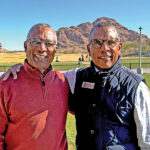Better Golf
LEARNING TO TRAIN THE BRAIN
Ciaran Carr, PGA, General Manager, Wintonbury Hills Golf Course, Bloomfield, Connecticut
Text by Tony L. Starks, originally published in the July issue of PGA Magazine.
Arnold Palmer once said: “Golf is a game of inches. The most important are the six inches between your ears.”
This famous Palmer quote perfectly emphasizes the mental aspects of the game. While teaching philosophies and swing theories may vary, it’s important that PGA of America professionals recognize and embrace the roles they play in developing the mental fortitude of their students.
That’s why Ciaran Carr, the 2015 Connecticut PGA Section Bill Strausbaugh Award winner, believes that knowing a little bit about how the human brain works can pay big dividends as an instructor.
“Every coach is different, every player is different. Some golfers like to practice, some like to play. But one skill I think a lot of coaches would see a boost from is a little bit of neuroscience knowledge about the mind and how it works when someone is playing,” says Carr, PGA, general manager at Wintonbury Hills Golf Course, a Troon-managed facility in Bloomfield, Connecticut. “But don’t be intimidated: you don’t need to know that much to make a huge impact.”
As Carr (pictured) explains in basic terms, the left side of the brain is where anxiety comes from — “Oh no, there’s a bunker, there’s out of bounds, etc.” — so he works with individuals to home in on the right side of their brains, the side that functions on creativity, artistry, and music skills. He accomplishes this by helping his students develop a cadence to block out the noise and focusing on a lot of visualization, too.
“First of all, and most importantly, some players love this stuff, some won’t. But having just some knowledge about the brain and helping create a pre-swing routine for your students can go a long way to further their success down the line,” Carr continues. “I talk about this a lot in my philosophy, and I try to be as transparent as possible about it.”
One thing he’s found success with is a pre-swing count-up of sorts. He encourages students to have a trigger such as: “1-2-3-go” or something similar. Counting pre-shot keeps the swing thoughts away and also sets the rhythm for the swing. The results have led to better course management, more sustained energy throughout the round, and an overall greater sense of confidence on the course.
And while none of this will fix a swing flaw, it helps make the teaching process more efficient and helps his students see results faster. Overall, Carr believes this approach not only improves technical skills but also fosters mental resilience, making a significant difference in player performance and on-course satisfaction.










